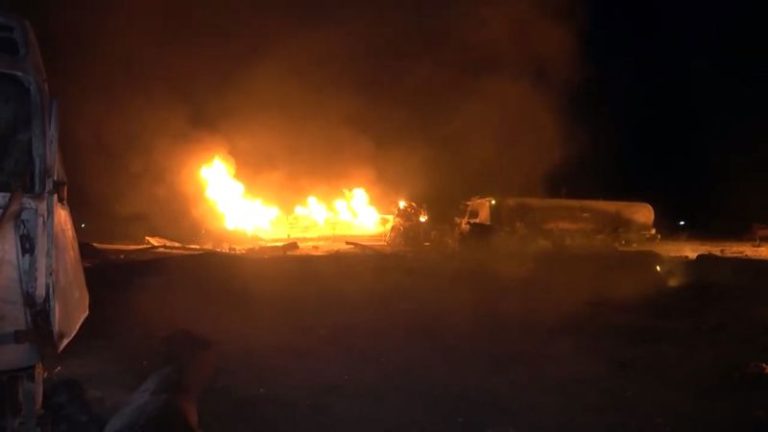Hamas has rejected the Israeli ceasefire offer presented earlier this week, according to a senior Hamas official, instead calling for a “comprehensive” proposal to end the war.
The rejection prompted far-right Israeli lawmakers to issue calls for an immediate escalation in Gaza, urging Prime Minister Benjamin Netanyahu to unleash “hell” and pursue “complete victory.”
The Israeli ceasefire proposal did not guarantee an end to the war and called for a disarmament of Gaza, both of which have been red lines for Hamas. The militant organization refuses to give up its weapons and demands that any proposal includes a permanent end to the war.
“We want a comprehensive package,” the official said.
The Israeli plan called for a 45-day truce, during which the two sides would aim to negotiate a permanent ceasefire.
Under the proposal, the remaining 59 hostages would be released in stages, starting with American-Israeli Edan Alexander on the first day of the truce as a “special gesture” to the United States. A further nine Israeli hostages would be released in two stages in exchange for 120 Palestinian prisoners serving life sentences and more than 1,100 detainees held without charge since October 7, 2023.
Israel’s proposal also demands that Hamas provide information about the remaining living Israeli hostages held by the group, “in exchange for information about the Palestinian detainees,” and the release of the bodies of 16 deceased Israeli hostages for the remains of 160 deceased Palestinians held by Israel.
Hamas studied the proposal for several days before responding. But from the beginning, the proposal stood little chance of success. Hamas had repeatedly made clear that it demanded an end to the war as part of any hostage release, and it refused calls for a complete disarmament. Hamas also called for a complete withdrawal of Israeli forces from Gaza, whereas the Israeli proposal only included a temporary redeployment of the military.
In a televised statement from Qatar on Thursday night, Khalil Al-Hayya, the head of the negotiating delegation, said, “The resistance and its weaponry are linked to the existence of the (Israeli) occupation, and it is a natural right for our people and all peoples under occupation.”
Al-Hayya insisted that Hamas is “immediately” ready to begin negotiations for a comprehensive agreement that would see the release of the remaining hostages for an “agreed-upon number” of Palestinian prisoners. Such an agreement would include the beginning of Gaza’s reconstruction and an end to the blockade of Gaza.
Far-right Israeli Finance Minister Bezalel Smotrich said that Israel would continue its bombardment of Gaza. “The state of Israel shall not surrender to Hamas and won’t end the war without the complete victory and fulfillment of all its objectives, including eliminating Hamas and returning all the hostages,” he said in a statement.
National Security Minister Itamar Ben Gvir echoed Smotrich, writing on Telegram: “No deal, no ceasefire, and no aid – only the continuation of fighting until the surrender of the Nazis from Gaza. Activate all force and might until Hamas begs on its knees.”
The Hope Forum, a right-wing group representing hostages’ families, tweeted: “Only massive military pressure, a total blockade, and capturing territory will force Hamas to beg for a deal. What are you waiting for?!”
Israel shut off humanitarian aid and supplies going into the coastal enclave in early-March, igniting a humanitarian crisis that UN officials says is the worst since the war began. Israel’s renewed assault on Gaza has displaced more than 500,000 Palestinians in less than a month, according to the UN Office for the Coordination of Humanitarian Affairs. The Palestinian Ministry of Health in Gaza says that the attacks on Gaza have killed nearly 1,700 Palestinians since March 18.
Israel has argued that the humanitarian blockade has pressured Hamas into agreeing to a ceasefire. On Wednesday, Defense Minister Israel Katz said, “The pressure on Hamas to carry out the deal is heavy and the tension between it and the local population is increasing.”
But that pressure has failed to force Hamas into accepting the latest proposal.
The United Nations issued a dire warning over the rapidly deteriorating humanitarian situation in Gaza, saying lifesaving supplies were nearing “total depletion” due to Israel’s block on aid.
More than 2 million people remain trapped in the besieged enclave, with mental health needs skyrocketing, critical infrastructure in ruins, and essential services on the brink of collapse, Stéphane Dujarric, spokesman for the UN Secretary-General, told a press briefing.
Dujarric said that nearly 90% of water infrastructure – including wells, pumping stations, and sewage plants – had been destroyed or damaged by hostilities, exacerbating disease risks and forcing families to rely on unsafe sources.
“Stress levels, particularly among children, are surging as violence and deprivation persist,” Dujarric said, emphasizing that Israel, as the occupying power, bears legal obligations under international law to ensure access to food, medical care, and public health services. The UN reiterated demands for urgent humanitarian access, warning that delays risk mass preventable deaths.
Israel launched its war on Hamas in Gaza in October 2023, following the militant group’s surprise attack on southern Israel that killed 1,200 people and saw 251 taken hostage, according to Israeli authorities.
More than 51,000 Palestinians have been killed in Gaza since then, according to the health ministry in the enclave.
This post appeared first on cnn.com










